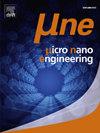PECVD 氮化硅薄膜在 MEMS 传感器空腔中释放氢气
IF 3.1
Q2 ENGINEERING, ELECTRICAL & ELECTRONIC
引用次数: 0
摘要
在这项工作中,我们研究了基于 MEMS 的惯性传感器空腔中 PECVD 氮化硅薄膜释放氢气的情况。首先,我们对两种类型的 PECVD 氮化硅薄膜进行了材料表征,用分析方法研究了氢气的释放。在基于 MEMS 的惯性传感器功能微芯片的帮助下,还通过实验研究了这些材料在 MEMS 传感器封装腔中的氢气释放及其对腔压的影响。根据我们的研究结果和其他研究报告,我们提出了所研究的微芯片在不同制造过程中腔体压力发生变化的步骤。我们认为,氢气是在晶片键合过程中以高温形式从 PECVD 氮化硅薄膜中释放出来的,然后在传感器的整个生命周期中以低压在腔体内扩散。本文章由计算机程序翻译,如有差异,请以英文原文为准。

Release of hydrogen gas from PECVD silicon nitride thin films in cavities of MEMS sensors
In this work we investigate the release of hydrogen gas from PECVD silicon nitride thin films in the cavities of MEMS based inertial sensors. Firstly, material characterization is conducted on two types of PECVD silicon nitride thin films to study the release of hydrogen gas with analytical methods. The release of hydrogen gas from these materials in encapsulated cavities of MEMS sensors, and its influence on the cavity pressure is also investigated experimentally with the help of functional microchips of MEMS based inertial sensors. Based on our findings and reports from other works, we propose steps by which change in the cavity pressure of the investigated microchip occurs over its different fabrication processes. We suggest that hydrogen gas is released form PECVD silicon nitride thin films at high temperatures during wafer bonding, which can then diffuse in cavities at low pressure over the lifetime of the sensor.
求助全文
通过发布文献求助,成功后即可免费获取论文全文。
去求助
来源期刊

Micro and Nano Engineering
Engineering-Electrical and Electronic Engineering
CiteScore
3.30
自引率
0.00%
发文量
67
审稿时长
80 days
 求助内容:
求助内容: 应助结果提醒方式:
应助结果提醒方式:


